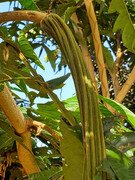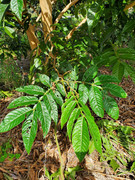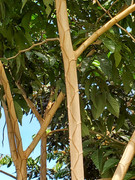I have an orchard in Hamakua. Have been testing over 50 varieties for around 20 years. My orchard is right at sea level, so in a much better location for producing mangoes than yours. Sorry to tell you but you are probably in one of the worst locations in Hawaii for getting consistent fruiting of manoges. Your location is way too rainy. Honestly your best bet would be to try to plant some trees along the coast somewhere if at all possible.
If that is not possible then HiFarm gave you a good suggestion: Mangifera odorata (Kuini). However he is wrong in saying that species is the one that tastes most like mango. Actually Mangifera kasturi tastea a lot more like mango. I like kasturi a lot more than the kuini. The kuini has a very strong odor and turpentine taste. The lonly drawback with the kasturi is that it is small and a bit stringy. You should also try lalee jewo.
If you still want to try mangoes at your location i would suggest planting them under plastic cover. Maybe put them in very large pots, and in the winter when they flower move them under clear plastic. You will still get some anthracnose due to very high air humidity.
The cultivars i have found to be most anthracnose resistant are: Fairchild, Florigon, Brook's Late, Neelam, Nam Doc Mai, Rapoza. If you combine placing them under plastic cover with spraying copper sulphate then you could get a decent fruit set. If you are like most you will probably revert to buying Kona mangoes.
If you want to get scion wood i do sell it, check out my list at http://fruitlovers.com/Scions.html
Glad you weighed in on this Oscar, I was hoping you would. I haven't tried kasturi yet (tree is still too young) so I was hesitant to say it tasted like mango without first hand knowledge. I haven't had lalijiwa for probably a couple of years but my recollection it was very good but a bit different flavor from an indica mango. The kuini I had definitely had a strong odor (but, like some other fruits, seemed better if you peeled it and enjoyed the flesh somewhere away from the peel). There was definitely some turpentine component but didn't seem too bad (I've had noname mango here that was as bad or worse for turp).
Glad to hear that the clones I selected are among your best performers, Oscar, maybe I'll get a mango or two on rare occasions. Year before last, I thought I had it made with my Keitt. The first flush of flowering resulted in dozens of set fruits, even with the frequent rain. A second flush came, again with frequent rain, with about zero fruit set. Then the first fruits gradually began getting fungused, despite spraying and drier weather. A lot of them got bigger than a walnut, maybe duck egg size and then poof, they all dropped shortly thereafter.




